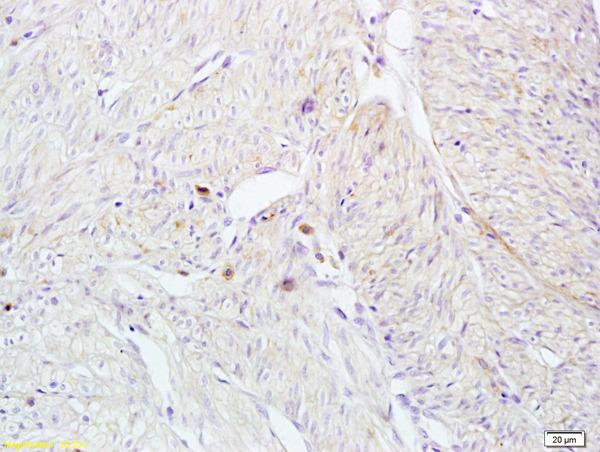![FACS analysis of human peripheral blood lymphocytes using GTX01454-06 CD161 antibody [HP-3G10] (FITC). Solid lone : primary antibody Dashed line : isotype control antibody amount : 0.5 microg (5 microl) FACS analysis of human peripheral blood lymphocytes using GTX01454-06 CD161 antibody [HP-3G10] (FITC). Solid lone : primary antibody Dashed line : isotype control antibody amount : 0.5 microg (5 microl)](https://www.genetex.com/upload/website/prouct_img/normal/GTX01454-06/GTX01454-06_20200428_FACS83_w_23053121_907.webp)
FACS analysis of human peripheral blood lymphocytes using GTX01454-06 CD161 antibody [HP-3G10] (FITC). Solid lone : primary antibody Dashed line : isotype control antibody amount : 0.5 microg (5 microl)
CD161 antibody [HP-3G10] (FITC)
GTX01454-06
ApplicationsFlow Cytometry
Product group Antibodies
TargetKLRB1
Overview
- SupplierGeneTex
- Product NameCD161 antibody [HP-3G10] (FITC)
- Delivery Days Customer9
- Application Supplier NoteFACS: 0.5 microg (5 microl) for 105-108 cells in 100 microl sample per test. *Optimal dilutions/concentrations should be determined by the researcher.Not tested in other applications.
- ApplicationsFlow Cytometry
- CertificationResearch Use Only
- ClonalityMonoclonal
- Clone IDHP-3G10
- Concentration0.1 mg/ml
- ConjugateFITC
- Gene ID3820
- Target nameKLRB1
- Target descriptionkiller cell lectin like receptor B1
- Target synonymsCD161, CLEC5B, NKR, NKR-P1, NKR-P1A, NKRP1A, hNKR-P1A, killer cell lectin-like receptor subfamily B member 1, C-type lectin domain family 5 member B, killer cell lectin-like receptor subfamily B, member 1, natural killer cell surface protein P1A
- HostMouse
- IsotypeIgG1
- Protein IDQ12918
- Protein NameKiller cell lectin-like receptor subfamily B member 1
- Scientific DescriptionNatural killer (NK) cells are lymphocytes that mediate cytotoxicity and secrete cytokines after immune stimulation. Several genes of the C-type lectin superfamily, including the rodent NKRP1 family of glycoproteins, are expressed by NK cells and may be involved in the regulation of NK cell function. The KLRB1 protein contains an extracellular domain with several motifs characteristic of C-type lectins, a transmembrane domain, and a cytoplasmic domain. The KLRB1 protein is classified as a type II membrane protein because it has an external C terminus. [provided by RefSeq, Jul 2008]
- Storage Instruction2°C to 8°C
- UNSPSC12352203
References
- Krüger R, Martin E, Dmytrus J, et al. CD70 Deficiency Associated With Chronic Epstein-Barr Virus Infection, Recurrent Airway Infections and Severe Gingivitis in a 24-Year-Old Woman. Front Immunol. 2020,11:1593. doi: 10.3389/fimmu.2020.01593Read this paper
- Rodriguez L, Pekkarinen PT, Lakshmikanth T, et al. Systems-Level Immunomonitoring from Acute to Recovery Phase of Severe COVID-19. Cell Rep Med. 2020,1(5):100078. doi: 10.1016/j.xcrm.2020.100078Read this paper
- Schulte-Schrepping J, Reusch N, Paclik D, et al. Severe COVID-19 Is Marked by a Dysregulated Myeloid Cell Compartment. Cell. 2020,182(6):1419-1440.e23. doi: 10.1016/j.cell.2020.08.001Read this paper
- Sztein MB, Bafford AC, Salerno-Goncalves R. Salmonella enterica serovar Typhi exposure elicits ex vivo cell-type-specific epigenetic changes in human gut cells. Sci Rep. 2020,10(1):13581. doi: 10.1038/s41598-020-70492-2Read this paper
- Guo N, van Unen V, Ijsselsteijn ME, et al. A 34-Marker Panel for Imaging Mass Cytometric Analysis of Human Snap-Frozen Tissue. Front Immunol. 2020,11:1466. doi: 10.3389/fimmu.2020.01466Read this paper
- Gruber CN, Calis JJA, Buta S, et al. Complex Autoinflammatory Syndrome Unveils Fundamental Principles of JAK1 Kinase Transcriptional and Biochemical Function. Immunity. 2020,53(3):672-684.e11. doi: 10.1016/j.immuni.2020.07.006Read this paper
- Cytlak U, Resteu A, Pagan S, et al. Differential IRF8 Transcription Factor Requirement Defines Two Pathways of Dendritic Cell Development in Humans. Immunity. 2020,53(2):353-370.e8. doi: 10.1016/j.immuni.2020.07.003Read this paper
- Bennstein SB, Weinhold S, Manser AR, et al. Umbilical cord blood-derived ILC1-like cells constitute a novel precursor for mature KIR(+)NKG2A(-) NK cells. Elife. 2020,9. doi: 10.7554/eLife.55232Read this paper
- Sharma M, Zhang S, Niu L, et al. Mucosal-Associated Invariant T Cells Develop an Innate-Like Transcriptomic Program in Anti-mycobacterial Responses. Front Immunol. 2020,11:1136. doi: 10.3389/fimmu.2020.01136Read this paper
- Uchida AM, Boden EK, James EA, et al. Escherichiacoli-Specific CD4+ T Cells Have Public T-Cell Receptors and Low Interleukin 10 Production in Crohn's Disease. Cell Mol Gastroenterol Hepatol. 2020,10(3):507-526. doi: 10.1016/j.jcmgh.2020.04.013Read this paper





![FACS analysis of human peripheral blood lymphocytes using GTX01454-07 CD161 antibody [HP-3G10] (APC). Solid lone : primary antibody Dashed line : isotype control antibody amount : 0.25 microg (5 microl)](https://www.genetex.com/upload/website/prouct_img/normal/GTX01454-07/GTX01454-07_20200428_FACS25_w_23053121_702.webp)
![FACS analysis of human peripheral blood lymphocytes using GTX01454-08 CD161 antibody [HP-3G10] (PE). Solid lone : primary antibody Dashed line : isotype control antibody amount : 0.5 microg (5 microl)](https://www.genetex.com/upload/website/prouct_img/normal/GTX01454-08/GTX01454-08_20200428_FACS118_w_23053121_361.webp)
![FACS analysis of human peripheral blood lymphocytes using GTX01454-11 CD161 antibody [HP-3G10] (PerCP-Cy5.5). Solid lone : primary antibody Dashed line : isotype control antibody amount : 0.5 microg (5 microl)](https://www.genetex.com/upload/website/prouct_img/normal/GTX01454-11/GTX01454-11_20200428_FACS165_w_23053121_576.webp)